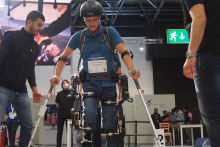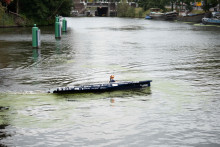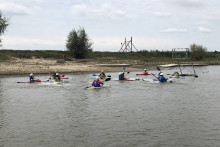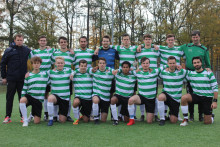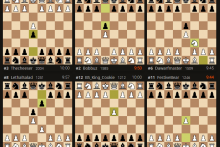The race took place during the weekend in Düsseldorf at the REHACARE, the world’s largest rehabilitation fair. The UT was represented by the Symbitron Plus team consisting of members from the University of Twente, Revalidatiecentrum Roessingh and TU Delft. The team leader and a UT researcher Edwin van Asseldonk looks back at the experience.
Can you tell us more about the competition?
‘It was essentially a demo race organized by Cybathlon as a preparation for the big Cybathlon championship in 2020. There were several races for different types of technologies, including exoskeletons, wheelchairs, prosthetic arms and legs. We participated in the exoskeleton competition on Friday and Saturday, using an exoskeleton developed by the UT with collaboration with TU Delft.’
What did this exoskeleton race look like?
‘We had two races each day. There were four different obstacles the pilot in the exoskeleton had to get through. The first one was “sit down and stand up” challenge. The challenge was to sit down on a soft and low sofa and then stand up again. The second obstacle was walking on an uneven terrain, the third one involved walking up a slope and the final one was walking up and down the stairs. You got points for each challenge, but only if the pilot managed to complete it without any external help. Unfortunately we experienced some technical issues and we had to unplug and restart the exoskeleton, so we couldn’t get any points for some challenges.’
What type of issues did you experience?
‘General issues really. We first thought it was electronic but it later turned out it was caused also by mechanical problems. We worked through it and we managed to show our exoskeleton worked. It was the first time we were participating in such a race, so now we know how to better prepare for the next time. This was our preparation for the big race in 2020 in Zurich.’
What was your overall result?
‘We ended up second, but there were only two teams participating in the exoskeleton race. What was nice, however, was the response we got. Exoskeletons can be very robotic, but we got a lot of compliments that ours looked and moved very naturally. Moreover, our pilot is a man with a spinal cord injury who can’t walk. When he started training in June he thought he would never ever be able to walk up the stairs in the exoskeleton, but now he managed without problems which was a nice moment. It was a great opportunity for the pilots to meet and exchange experience because you otherwise don’t meet other people who use an exoskeleton.’


